#singapore 1960
Explore tagged Tumblr posts
Text




Singapore (1960) | dir. Shakti Samanta
[ Shammi Kapoor and Padmini ]
#singapore#singapore 1960#shakti samanta#shammi kapoor#padmini#indian cinema#hindi cinema#bollywood#cinema#movies#films#old bollywood#world cinema#classic cinema#1960s#cinematography#south asian cinema#asian cinema#indian movies#bollywood movies#hindi movies#indian films#bollywood films#hindi films#classic bollywood#film scenes#movie scenes
19 notes
·
View notes
Text

Prince's Hotel Garni in Singapore
British vintage postcard, mailed in 1960 to The Hague, Netherlands
#tarjeta#postkaart#sepia#prince's#carte postale#ansichtskarte#singapore#the hague#hotel garni#mailed#briefkaart#photo#photography#postal#postkarte#vintage#british#netherlands#garni#postcard#historic#hotel#prince#hague#ephemera#1960
3 notes
·
View notes
Text

#edit#poster#edits 2024#msposter#lust in the dust#divine#dorothy lamour#road to singapore#hannibal brooks#challengers#michael j. pollard#oliver reed#zendaya#dispair#rainer werner fassbinder#volker spengler#hollywood#cinema#movies#introvert film weekend#old hollywood#1970s#1960s#2020s#1940s#1980s
2 notes
·
View notes
Text

15 notes
·
View notes
Text
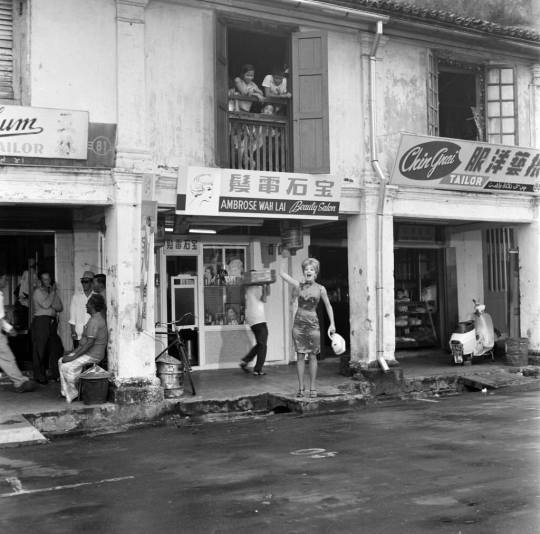


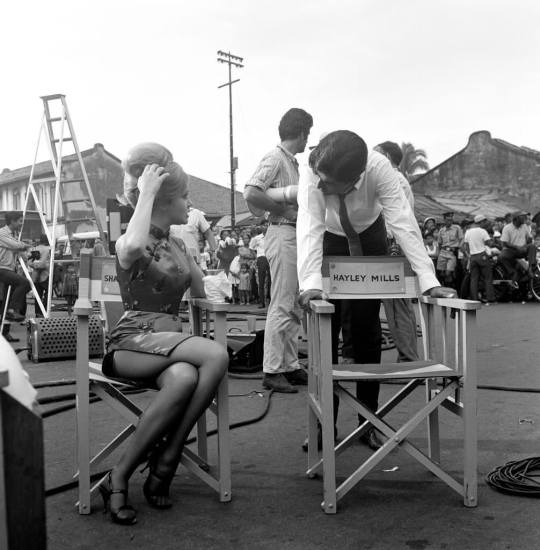
What Singapore looked like in the 1960s Through These Stunning Historical Photos
2 notes
·
View notes
Text
youtube
This is our breakbeat remix live synth jam of Alompak Agogo by The Swallows! I was invited by the Synth Commune of Singapore to play live at the Robo Agogo event on 7 October and the theme was 1960s Singapore pop and go-go music, so I remixed a few favourites and jammed them with my friends Michael Spicer
THE EVENT: ROBO AGOGO
"The swinging 60s and hippie 70s gave the world some of its most iconic music. It was also the golden era of original pop and rock in Singapore with bands like the Crescendos and The Quests outselling the Beatles!"
On 7 October 2023 the Synth Commune of Singapore threw a party in tribute to these times, but with their own twist where music from Singapore's 60s, 70s, 80s era came alive in a whole new Electronica format!
THE MUSICIANS
Abyss Simian (Ben Ang) on Korg Keytar and Ableton Push 3
Michael Spicer on Arp Odyssey
Falling Islands (Tan E-Reng) on Elektron Syntakt, Elektron Digitakt, Arturia Minifreak
THIS ARRANGEMENT
Breakbeat / Big Beat / Drum & Bass Remix by Abyss Simian
THE ORIGINAL SONG: ALOMPAK AGOGO by THE SWALLOWS
Link to original song https://youtu.be/FTXCWcR8pbc?si=qMcjgiaD10vJA9qb
Link to article about its meaning (the song is Indonesian dialect)
Link to a blog post about the song, in Bahasa Indonesia / Malay
0 notes
Text
The Great Singapore Penis Panic of 1967
Where hundreds of victims thought their penises were shrinking away, a dozen of which were women.
click here to learn more
#Singapore#the more you know#funnytumblr#funny post#tumblr memes#the more you learn#interesting#knowledge sharing#fun facts#random facts#history#world history#60s#1960s
0 notes
Text
Toa Payoh's early years as a public housing estate
Toa Payoh, the first satellite town that the Housing and Development Board planned in full, was recently in the news, having been the subject of a refreshed National Heritage Board (NHB) heritage trail. As part of the NHB’s efforts to update the trial, two markers have been added: one is sited at Toa Payoh’s now famous dragon playground, and the other at the so-called VIP block, Block 53. The…

View On WordPress
#1960s Toa Payoh#1970s Toa Payoh#Block 53 Toa Payoh#Changing Landscapes#Development of Toa Payoh#Dragon Playground#Life in Toa Payoh#Old Places#Playground#Playgrounds#Playgrounds of Old#Queen Elizabeth II&039;s visit to Toa Payoh#Singapore#Toa Payoh Heritage Trail
0 notes
Text
"Namibia is the driest country in Sub-Saharan Africa, and home to two of the world’s most ancient deserts, the Kalahari and the Namib. The capital, Windhoek, is sandwiched between them, 400 miles away from the nearest perennial river and more than 300 miles away from the coast. Water is in short supply.
It’s hard to imagine life thriving in Windhoek, yet 477,000 people call it home, and 99 per cent of them have access to drinking water thanks to technology pioneered 55 years ago on the outskirts of the city. Now, some of the world’s biggest cities are embracing this technology as they adapt to the harshest impacts of climate change. But Namibia leads the way.
How did this come about? In the 1950s, Windhoek’s natural resources struggled to cope with a rapidly growing population, and severe water shortages gripped the city. But disaster forced innovation, and in 1968 the Goreangab Water Reclamation Plant in Windhoek became the first place in the world to produce drinking water directly from sewage, a process known as direct potable reuse (DPR).
That may sound revolting, but it’s completely safe. Dr Lucas van Vuuren, who was among those who pioneered Windhoek’s reclamation system, once said that “water should not be judged by its history, but by its quality”. And DPR ensures quality.
This is done using a continuous multi-barrier treatment devised in Windhoek during eight years of pilot studies in the 1960s. This process – which has been upgraded four times since 1968 – eliminates pollutants and safeguards against pathogens by harnessing bacteria to digest the human waste and remove it from the water. This partly mimics what happens when water is recycled in nature, but Windhoek does it all in under 24 hours...
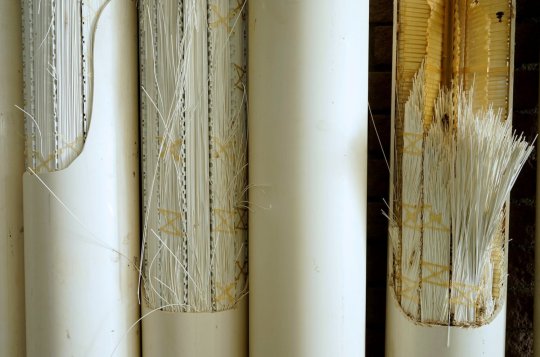
Pictured: These ultrafiltration membranes help to remove bacteria, viruses and pathogens. Image: Margaret Courtney-Clarke
“We know that we have antibiotics in the water, preservatives from cosmetics, anti-corrosion prevention chemicals from the dishwasher,” Honer explains. “We find them and we remove them.”
Honer adds that online instruments monitor the water continuously, and staff ensure that only drinking water that meets World Health Organisation (WHO) guidelines is sent to homes. If any inconsistencies are detected, the plant goes into recycle mode and distribution is halted until correct values are restored.
“The most important rule is, and was, and always will be ‘safety first’,” says Honer. The facility has never been linked to an outbreak of waterborne disease, and now produces up to 5.5m gallons of drinking water every day – up to 35 per cent of the city’s consumption.
Namibians couldn’t survive without it, and as water shortages grip the planet, Windhoek’s insights and experience are more important than ever.
Interest from superpowers across the globe
In recent years, delegations from the US, France, Germany, India, Australia, Singapore, and the United Arab Emirates have visited Windhoek seeking solutions to water shortages in their own countries.
Megadrought conditions have gripped the US since 2001, and the Colorado River – which provides 40 million people with drinking water – has been running at just 50 per cent of its traditional flow. As a result, several states including Texas, California, Arizona and Colorado are beginning to embrace DPR.
Troy Walker is a water reuse practice leader at Hazen and Sawyer, an environmental engineering firm helping Arizona to develop its DPR regulations. He visited Windhoek last year. “It was about being able to see the success of their system, and then looking at some of the technical details and how that might look in a US facility or an Australian facility,” he said. “[Windhoek] has helped drive a lot of discussion in industry. [Innovation] doesn’t all have to come out of California or Texas.”

Pictured: The internal pipes and workings of Namibia's DPR plant. As water becomes scarcer in some parts, countries are looking to DPR for solutions. Image: Margaret Courtney-Clarke
Namibia has also helped overcome the biggest obstacle to DPR – public acceptance. Disgust is a powerful emotion, and sensationalist ‘toilet to tap’ headlines have dismantled support for water reuse projects in the past. Unfortunately, DPR’s biggest strength is also its biggest weakness, as the speed at which water can re-enter the system makes it especially vulnerable to prejudice, causing regulators to hesitate. “Technology has never been the reason why these projects don’t get built – it’s always public or political opposition,” says Patsy Tennyson, vice president of Katz and Associates, an American firm that specialises in public outreach and communications.
That’s why just a handful of facilities worldwide are currently doing DPR, with Windhoek standing alongside smaller schemes in the Philippines, South Africa and a hybrid facility in Big Spring, Texas. But that’s all changing. Drought and increased water scarcity worldwide are forcing us to change the way we think about water.
Now, the US is ready to take the plunge, and in 2025, El Paso Water will begin operating the first ‘direct to distribution’ DPR facility in North America, turning up to 10m gallons of wasterwater per day into purified drinking water – twice as much as Windhoek. San Diego, Los Angeles, California, as well as Phoenix, Arizona are also exploring the technology."
Of course, DPR is not a silver bullet in the fight against climate change. It cannot create water out of thin air, and it will not facilitate endless growth. But it does help cities become more climate resilient by reducing their reliance on natural sources, such as the Colorado River.
As other nations follow in Namibia’s footsteps, Windhoek may no longer take the lead after almost six decades in front.
“But Windhoek was the first,” Honer reminds me. “No one can take that away.”"
-via Positive.News, August 30, 2023
#namibia#africa#desert#water shortage#water conservation#dpr#potable water#water recycling#clean water#drought#united states#colorado river#science and technology#sanitation#good news#hope
2K notes
·
View notes
Text
@thethirdman8 says, this looks like a fun night..






Psycho (1960)
dir. Alfred Hitchcock
(i watched this on the big screen with a live orchestra. pretty damn incredible.)


#bernard herrmann#psycho#anthony perkins#janet leigh#singapore symphonic orchestra#1960#dp: john l. russell#alfred hitchcock
12 notes
·
View notes
Text
what i read in 2023: best of
(full monthly lists) bold = favourite, * = interactive
investigative & longform journalism
shadow diplomats
the deputy and the disappeared* (usa)
adrift*
catching the men who sell subway groping videos (japan)
inside the secretive world of penile enlargement
have assisted dying laws gone too far? (canada)
the journalist and the pharma bro
raising the dead (south africa)
crime & justice
crime of the centuries
the indonesian children australia sent to adult jails for years*
the mercy workers (usa)
the occupation of water (palestine)
a hidden universe of suffering (palestine)
history
from mind control to murder
singapore's prison without walls made the world sit up in 1960s. how did it fall apart?* (interactive journey here)
the horrors of pompeii
blood on his hands* (cambodia)
culture & essays
quantum poetics
honey, i sold the kids
how to wash your hands in a war zone (colombia)
the strangely beautiful experience of google reviews
"blurred lines", harbinger of doom
the teacher crush
what kind of future does de-extinction promise?
#studyblr#studyspo#student#academia#university#literature#productivity#long reads#knife gang#myresources
271 notes
·
View notes
Text


Singapore (1960) | dir. Shakti Samanta
[ Shammi Kapoor and Padmini ]
#singapore#singapore 1960#shakti samanta#shammi kapoor#padmini#indian cinema#hindi cinema#bollywood#cinema#movies#films#old bollywood#world cinema#classic cinema#1960s#cinematography#south asian cinema#asian cinema#indian movies#bollywood movies#hindi movies#indian films#bollywood films#hindi films#classic bollywood#film scenes#movie scenes
6 notes
·
View notes
Text
The Mid-Autumn Festival (中秋节), a Chinese celebratory season observed by many East and Southeast Asians, has begun. Held on the 15th day of the eighth lunar month, which is in the middle of autumn, the festival marks the end of the season’s harvest and is a time to appreciate the moon at its fullest and brightest. Besides feasting eyes on the moon and lanterns of different shapes and sizes, Mooncakes (月饼), a rich pastry with all sorts of fillings, are undoubtedly the main highlight of the festival and are traditionally shared among family and friends.
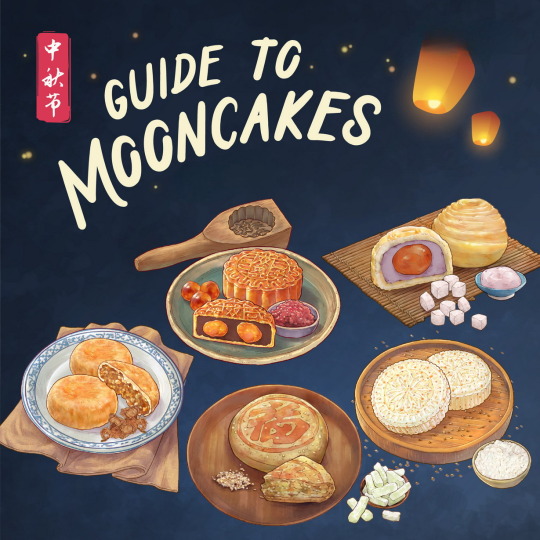
The Cantonese Mooncake (广式月饼) is the most commonly found traditional mooncake in Singapore. Its fillings consist of lotus seed or red bean paste and usually include one, two or four salted duck egg yolks. Many would also be familiar with the snow skin variant that was created in Hong Kong in the 1960s as a healthier alternative to traditional baked mooncakes. The fillings and a ball of dough are traditionally pressed into a wooden mould, which embosses intricate wordings of the pastry shop’s name or stuffing on top of the pastry.
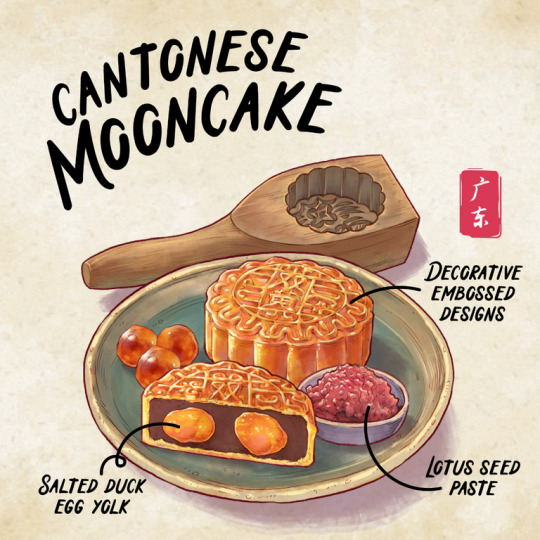
A mooncake with various flavours such as rich, savoury-sweet and peppery, the Hainanese Mooncake (海南月饼), also known as Su Yan Bing (酥盐饼) is traditionally filled with ingredients such as fried shallots, lard, salt, white pepper, rose-flavoured white sugar, sesame seeds, melon seeds and dried wild tangerine skin peel. The filling is encased in a thin crust made with flour, salt and lard.
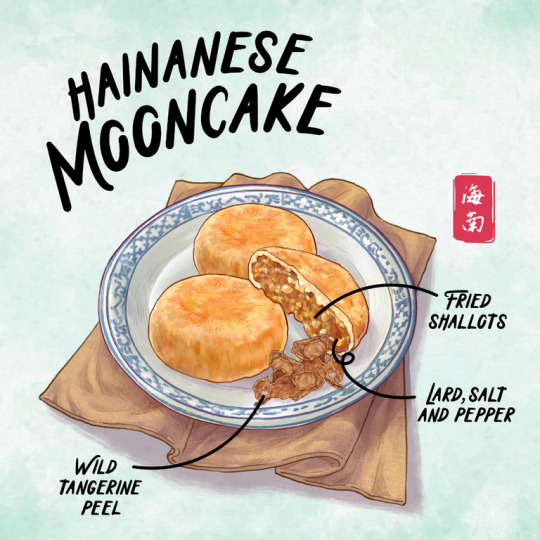
The Hakka Mooncake (客家月饼) is also called Yu Gao (月糕) and is a flat, snow-white disc that is typically made with cooked glutinous rice flour and sugar, giving it a crumbly and powdery texture. It is usually embellished with more intricate designs, often with animals and flowers. Although it doesn’t usually contain any fillings, some come with candied winter melon, desiccated coconut and sesame seeds mixed with glutinous rice flour, sugar, margarine and water.

Easily distinguishable by the red stamp of Chinese characters on the top of the crust and its white disc-shaped pastry which resembles a bright moon, the Hokkien Mooncake (福建月饼) consists of a dry and sweet filling that is made of candied winter melon, tangerine peel, melon seeds, sugar, and cooked with lard or peanut oil. A less common type is a savoury version with minced meat filling. Once known as Scholar Cakes (状元糕), they were given to those who took part in the Imperial examinations. Today, it is given as a symbol of good luck to those who are about to sit for their exams.
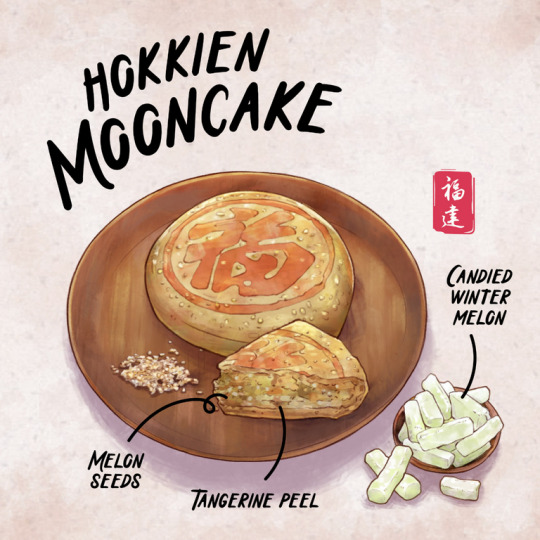
Many would be familiar with the Teochew Mooncakes (潮州月饼). It has a crispy, spiral-layered crust that crumbles easily. It originated from the Chaoshan (潮汕) area in Guangdong Province and typically consists of yam paste and a salted duck egg yolk. Other traditional versions of the Teochew mooncake are still made by old school bakeries in Singapore. For example, La Bia (朥饼 or lard biscuit), where ‘La’ refers to pork oil, has a thinner, flaky crust with a thick mung bean or red bean filling. There are also alternative fillings including red bean, mung bean or lotus seed paste. There is also a steamed version of the typically baked Teochew mooncake, called La Gao (朥糕). It can either be served plain or with a mung bean filling.
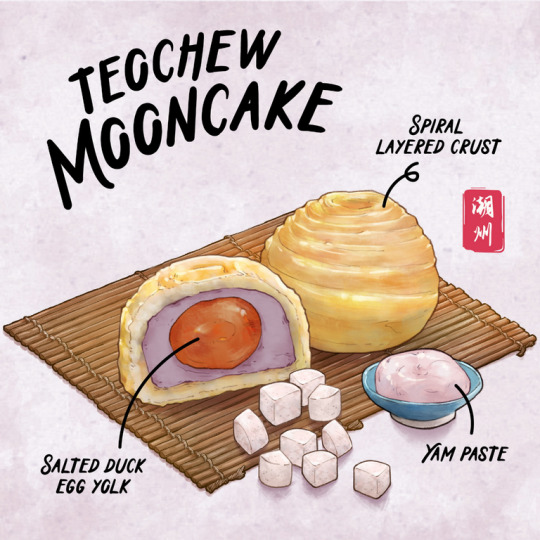
A Snow Skin Mooncake (冰皮月饼) variant was created in Hong Kong in the 1960s as a healthier alternative to traditional baked mooncakes. Similar to mochi, its crust is made of glutinous rice flour and varies in colour, based on the flavours used. And unlike traditional mooncakes, these are best served cold!
youtube
Mooncake information and drawings courtesy of Ministry of Culture, Community and Youth.
#Mid-Autumn Festival#中秋节#Mooncake Festival#农历八月十五#Chinese Culture#Chinese Tradition#Celebration#Mooncake#月饼#Cantonese Mooncake#广式月饼#Hainanese Mooncake#海南月饼#Hakka Mooncake#客家月饼#Hokkien Mooncake#福建月饼#Teochew Mooncake#潮州月饼#Snow Skin Mooncake#冰皮月饼#Recipe#Video#Youtube#Snack#Dessert#Asian Food#Food#Buffetlicious
127 notes
·
View notes
Text

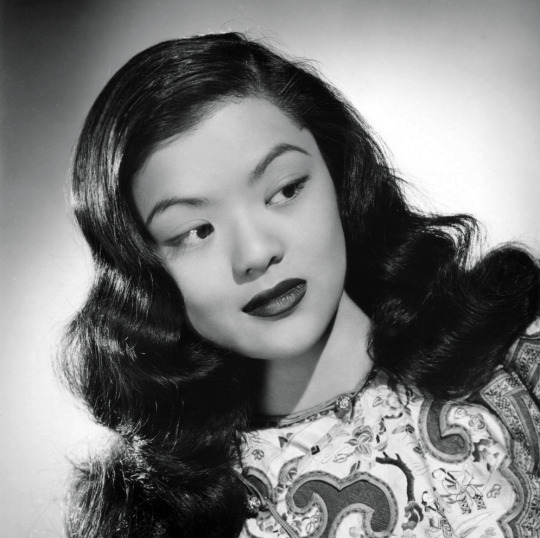
Propaganda
Marilyn Monroe (How to Marry a Millionaire, Gentlemen Prefer Blondes, Some Like It Hot)— Ngl I thought you all were lying about sexual attraction until I saw Marilyn Monroe in Gentlemen Prefer Blondes
Maylia Fong (Singapore, To the Ends of the Earth)—I’m so so so into her brand of old Hollywood glamor Idk where even to Begin to describe ittttt
This is round 3 of the tournament. All other polls in this bracket can be found here. Please reblog with further support of your beloved hot sexy vintage woman.
[additional propaganda submitted under the cut.]
Maylia Fong:

Marilyn Monroe:

She's amazing!!! A classic bombshell, as well as a strong women who overcame so many obstacles. She also advocated for others, like Ella Fitzgerald.

That fucking saxophone that cuts in whenever she appears on screen in Some Like it Hot

I mean, it's Marilyn Monroe. She's adorable. She's gorgeous. She funny. She's the total package

She's the original American sex symbol, an iconic beautiful woman with eyes you could get lost in, legs for days, gorgeous hair, and a cute tummy. Her voice! Just listen to her voice!!!!!
youtube
She is considered one of THE sex symbols of the 1960s and one of the greatest actresses of all time! She HAS to be on this list!

no vintage movie woman is more iconically hot
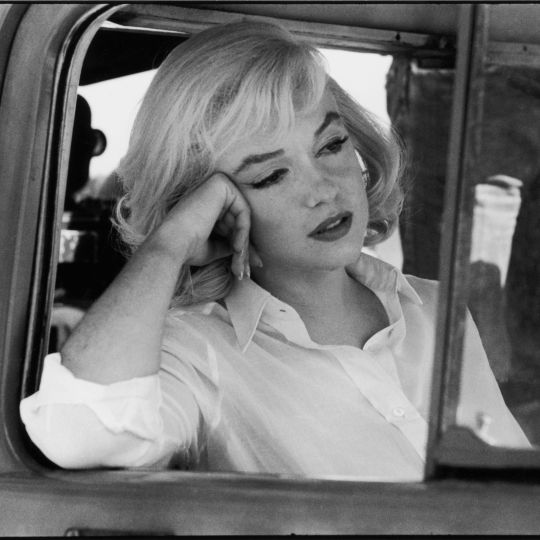
People are most familiar with pictures of her in the white dress or the Happy Birthday Mr President one, but imo she is at her most beautiful and looks most comfortable when she is photographed by women like Eve Arnold

It’s Marilyn Monroe. If Aphrodite was an actual person, she’d be Marilyn. Do I really need to say more?

What can I say that hasn't been said? Marilyn's legacy is so much bigger than she was in life. She's a defining symbol of 50s and 60s Hollywood sex and it's obvious why. She was absolutely stunning and the camera loved her.

138 notes
·
View notes
Text
So I shared, the Spanish-language horror visual references in this week’s Peaceful Property episode (which are great ghost story films for comparison in thematic elements, as well). The death this week, though, is yet another ghost story reference, this time in an English-language series with lots of commentary on class and the racial and gender politics of domestic work, The Haunting of Bly Manor.
🚨spoilers for both series from here on🚨


In Bly Manor, Hannah Grose, the estate’s maid is revealed late in the series to be a ghost, who had fallen into a well on the grounds. Although the series is based off Henry James’s Turn of the Screw and its celebrated film adaptation The Innocents from the 1960s and its celebrated 2000s remake The Others* with Nicole Kidman (in which the twist from the previous is that the governess main character is revealed to be dead), Hannah Grose’s death is a new addition in the Netflix series. It compounds the complex themes about class and domestic servitude in the original British story and adds issues of race to the proceedings.
Peaceful Property uses Baanchuen’s story for similar purposes. Migrant domestic work is an important issue in Southeast Asia. The International Labor Organization put out a report last year stating, “29 per cent of surveyed migrant domestic workers in Malaysia were in conditions meeting the ILO’s statistical definition of forced labour; as were 7 per cent of surveyed workers in Singapore and 4 per cent in Thailand. Indicators of involuntariness include not being able to quit your job, having to stay in the job longer than agreed, and being made to work without overtime pay, among others.” Shackles, like those on Baanchuen’s ghost, are an easily recognizable symbol of enslavement, indicating the extent of Aunt Phom’s cruelty.
But even under legal circumstances, domestic workers are one of the least protected group of laborers in Thailand and abroad. Taiwanese-American labor organizer, MacArthur “genius” grant recipient, and mentor/friend to BLM cofounder Alicia Garza, Ai-Jen Poo has a fantastic interview on On Being, in which she discusses the racialized, gendered, international, and cross-class dynamics that define domestic care work, which impacts the strategies to organizing for workers rights in the field.
“The average annual income for a home care worker [presumably in the US at the time of recording in 2020] is $15,000 per year. And I can’t think of any community that I’ve ever lived in where you can survive on $15,000 a year. It’s really quite extraordinary. And they’re there and see employers come home with a pair of shoes that are maybe more than they make in a week, and yet, their job is to care and support and love, and they do so. You can’t actually do your job as a caregiver if you dehumanize the person that is in your charge. And I think that that is so much of what’s needed in this moment. All of us need to understand that we have a profound set of challenges and inequities that we have to deal with and transform, but we have to do it with a boundless sense of compassion and humanity.”
I’d encourage some of my fellow watchers of Peaceful Property to heed Poo’s perspective on disrupting class distinctions and what the advocacy for equitable practices has looked like in her work. I’m a caseworker myself and have worked alongside people who had less privilege than me for caring wealthy people who never the less didn’t always recognize the value of those whose work they depended on and didn’t have the labor laws that might provide that guidance. There are a few pieces of work that explore this meaningfully (better than The Help, although Viola Davis and Octavia Spencer absolutely carved out depths in their characters stories that weren’t there on the page). Glad to see Peaceful Property making its attempt to explore these depths. It actually made me reflect on how many of the jobs after the first episode really focused on gendered aspects of labor—a wig-maker, assistants, food-making…
And for my Homepeach truthers out there, that gender conversation is not just about labor. Bly Manor is also notable for its queer romance storyline with a wealthier character running from her internalized homophobia/guilt after a car accident…
*Incidentally, The Others is also heavily influenced by the same Spanish film, The Spirit of the Beehive, as both referenced Spanish-language horror films in these weeks episode.
#peaceful property#peaceful property the series#on sale the series#peachhome#thai bl#gmmtv#the haunting of bly manor#bly manor#meta
30 notes
·
View notes
Text
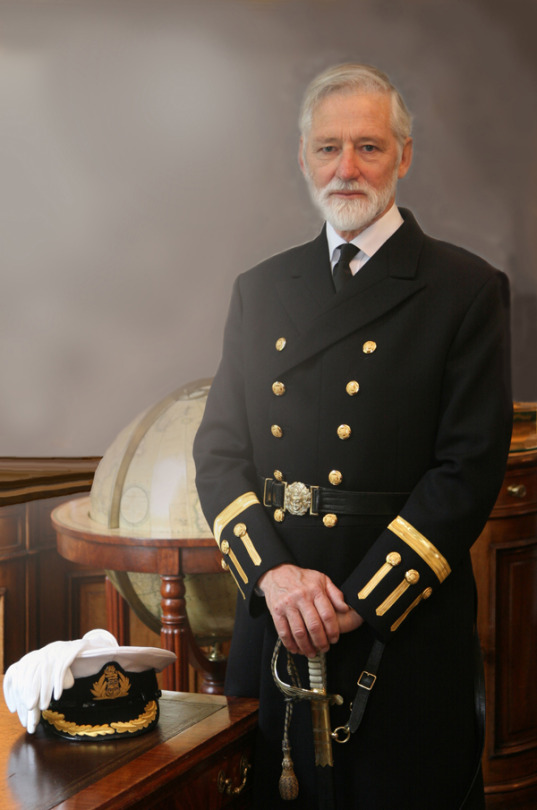
Richard Woodman
Writer who drew on his own experience at sea in a series of novels and historical works about the British merchant navy
“The end was anticlimax. We slipped home unnoticed. Britain turned no hair at our arrival, as just as she has turned no hair at our extinction.” When Richard Woodman published Voyage East in 1988, he knew that the mercantile world depicted within it, which he had joined aged 16, was gone.
The first-person novel – which never reads like fiction – describes the voyage of a cargo liner carrying goods and passengers from Liverpool to Singapore, Hong Kong, Kobe and Shanghai in the mid-1960s. There is a moment, off the coast of Borneo, when the captain sees a vessel with half a dozen grey aluminium boxes on her foredeck: “What the devil are they?” he asks the pilot. “‘They’re containers, Captain,’ the Pilot replied, and no one on the bridge heard the sentence of death pronounced upon us.”
Woodman, who has died aged 80, became the memorialist of the merchant fleets. Between 2008 and 2016 he wrote the history of the British merchant navy in five volumes, followed by A Low Set of Blackguards, a two-volume history (2016-17) of the East India Company.
His outstanding contribution came through his three second world war convoy histories: Arctic Convoys (1994), Malta Convoys (2000) and The Real Cruel Sea (2005). These are works of passion, based on experience and scrupulous research.
The loss of life among merchant seamen was proportionately greater than in any of the armed services and the recognition they received far less. From the beginning of the war a seafarer’s pay was stopped the minute his ship was sunk. “Time spent fighting for his life on a float or lifeboat was an unpaid excursion,” wrote Woodman.
While Winston Churchill acknowledged the crucial importance of the Battle of the Atlantic to national survival, it was not until 2012 that those who had served in the Arctic convoys, and had taken the highest casualties of all, were retrospectively honoured.
Born in north London, Richard was the elder son of Rosalie (nee Cann) and Douglas Woodman, a civil service administrator. Though he was far from the sea, his imagination was captured by the works of Arthur Ransome, Daniel Defoe, RM Ballantyne and Alan Villiers, and his enthusiasm nurtured by Sea Scout membership.
He was the youngest member of the Sea Scout crew that sailed the ex-German yawl Nordwind in the 1960 Tall Ships race and, despite failing all but two of his O-levels, he was accepted as an indentured apprentice with the Alfred Holt (Blue Funnel) line in 1960.
His first long trip to Australia came as a midshipman on the SS Glenarty, returning via the US: “I had been round the world before I would have been allowed inside a British pub.” Life on board ship took place in an uncompromising, all-male environment: the almost compulsory swearing, drinking and sexist banter encouraged the development of “a carapace behind which we hid our private selves”.
Woodman responded eagerly to the hands-on education in seamanship and navigation, developed his writing and sketching through the log-keeping and read his way through the excellent ships’ libraries provided by the Marine Society. He completed his four-year apprenticeship and gained his second mate’s certificate. He was, however, in love and hated saying goodbye to his girlfriend, Christine Hite, an art student, for many months at a time.
He left Blue Funnel in the mid-1960s and went to work for the Ocean Weather Service, where he discovered how vicious the North Atlantic winter weather systems could be – and how pitilessly an ex-second world war corvette would roll. Fortunately it was not long before a temporary position became available with Trinity House, the corporation charged with the maintenance of navigation marks around England, Wales and the Channel Islands.
The position became permanent; he and Christine married in 1969 and settled in Harwich, Essex, near the Trinity House east coast depot, and he served the corporation for most of the rest of his life.
The work at sea was varied, challenging, sometimes dangerous. Precise navigation, seamanship and attention to detail were essential qualities, but Woodman also found time to write. His first novel, The Eye of the Fleet, was published in 1981. This introduced a series of 14 adventures featuring the young Nathaniel Drinkwater, a hero somewhat in the Horatio Hornblower mode but bearing the unmistakable stamp of a writer who was also a sailor.
Despite his professional career being in motorised vessels, Woodman loved traditional gaff-rigged yachts, particularly his own Kestrel and then Andromeda, in which he and Christine explored the east coast rivers and beyond. The action of his nautical novels often turns on neat, seamanlike manoeuvres as well as including varied and closely observed seascapes.
His productivity was astonishing. He often wrote two or three novels a year and soon added non-fiction to his output. When he became captain of Trinity House Vessel Patricia, he achieved this by having two desks, one from which he could conduct official business, the other hidden behind a door, with a page from the work in progress always ready in the typewriter.
Meanwhile, in his job he was extremely focused, conscientious and painstaking. Although some remember him as being of the “old school”, Jill Kernick, the first woman in almost 500 years to work at sea for Trinity House, credits him with helping her break through traditional barriers in the early 80s.
In 1997 Woodman retired to write full time, but was soon elected a Younger Brother of Trinity House, and then an Elder Brother, the first time a former employee was accorded this honour. He was diagnosed with cancer in 2003 but there was no let-up in his work rate. His last completed novel, A River in Borneo (2022), harks back to 60s Indonesia but sets its final scene in a Colchester hospice.
He is survived by Christine and their children, Abigail and Edward, and grandson, Arlo.
🔔 Richard Martin Woodman, master mariner and author, born 10 March 1944; died 2 October 2024
Daily inspiration. Discover more photos at Just for Books…?
26 notes
·
View notes